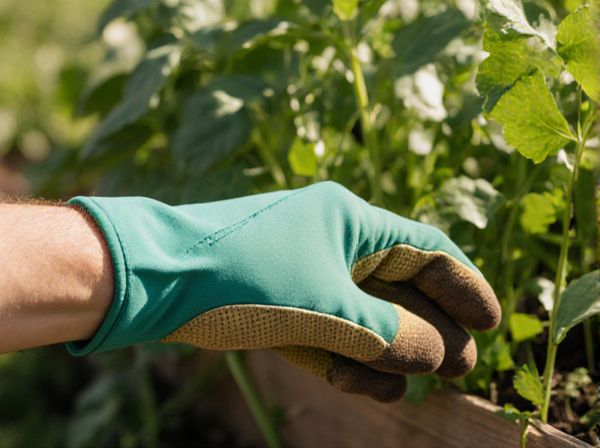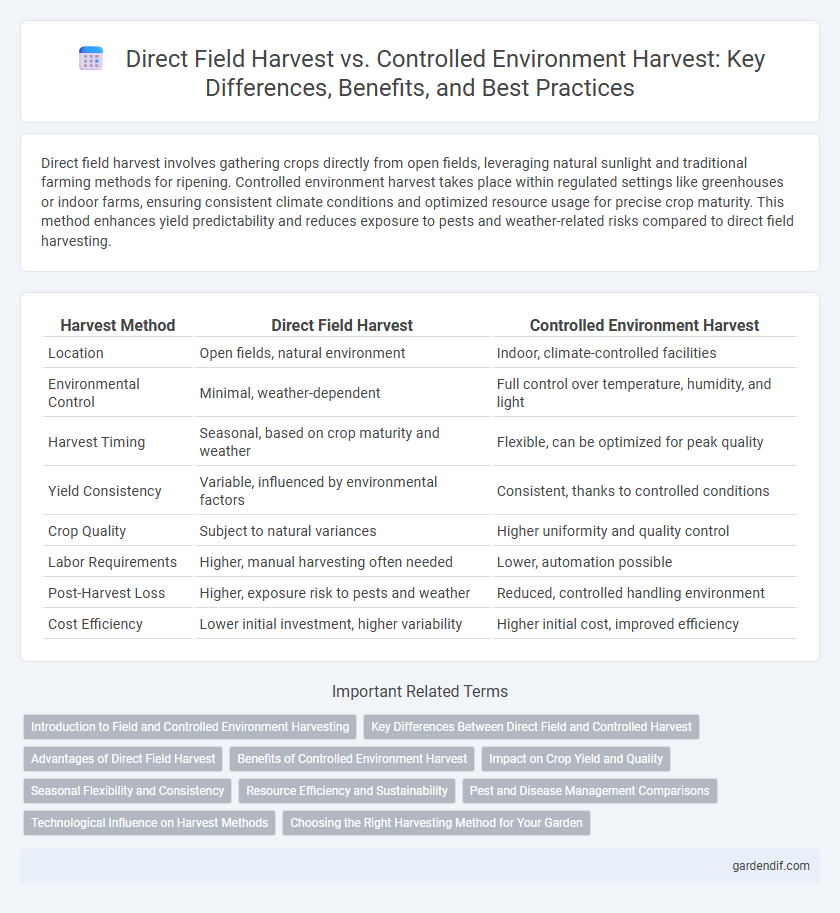
Direct Field Harvest vs Controlled Environment Harvest Illustration
Direct field harvest involves gathering crops directly from open fields, leveraging natural sunlight and traditional farming methods for ripening. Controlled environment harvest takes place within regulated settings like greenhouses or indoor farms, ensuring consistent climate conditions and optimized resource usage for precise crop maturity. This method enhances yield predictability and reduces exposure to pests and weather-related risks compared to direct field harvesting.
Table of Comparison
| Harvest Method | Direct Field Harvest | Controlled Environment Harvest |
|---|---|---|
| Location | Open fields, natural environment | Indoor, climate-controlled facilities |
| Environmental Control | Minimal, weather-dependent | Full control over temperature, humidity, and light |
| Harvest Timing | Seasonal, based on crop maturity and weather | Flexible, can be optimized for peak quality |
| Yield Consistency | Variable, influenced by environmental factors | Consistent, thanks to controlled conditions |
| Crop Quality | Subject to natural variances | Higher uniformity and quality control |
| Labor Requirements | Higher, manual harvesting often needed | Lower, automation possible |
| Post-Harvest Loss | Higher, exposure risk to pests and weather | Reduced, controlled handling environment |
| Cost Efficiency | Lower initial investment, higher variability | Higher initial cost, improved efficiency |
Introduction to Field and Controlled Environment Harvesting
Direct field harvest involves collecting crops at peak maturity directly from open agricultural fields, ensuring natural growth conditions optimize flavor and yield. Controlled environment harvest refers to gathering produce grown in greenhouse or indoor settings where temperature, humidity, and light are regulated to extend growing seasons and improve crop consistency. Both methods require specific techniques to maximize quality, reduce post-harvest losses, and meet market demands efficiently.
Key Differences Between Direct Field and Controlled Harvest
Direct field harvest relies on natural growth cycles and climatic conditions, leading to variable yield quality and timing. Controlled environment harvest ensures consistent crop production through regulated temperature, humidity, and light, maximizing yield predictability. Key differences include environmental control, resource efficiency, and crop quality uniformity.
Advantages of Direct Field Harvest
Direct Field Harvest offers significant advantages such as reduced operational costs and enhanced crop freshness by eliminating the need for intermediate storage or transport. It allows for large-scale production with minimal infrastructure, optimizing natural sunlight and soil nutrients for robust plant growth. This method also supports sustainable farming practices by minimizing energy consumption and preserving soil biodiversity.
Benefits of Controlled Environment Harvest
Controlled Environment Harvest enhances crop quality by regulating factors such as light, temperature, and humidity, resulting in higher nutrient density and consistent yields. This approach reduces pest exposure and minimizes the need for pesticides, promoting sustainable agricultural practices. Controlled environments also enable precise harvesting schedules, increasing operational efficiency and reducing post-harvest losses.
Impact on Crop Yield and Quality
Direct field harvest often results in higher variability in crop yield and quality due to exposure to unpredictable weather, pests, and soil conditions. Controlled environment harvests utilize regulated temperature, humidity, and light to optimize plant growth, leading to more consistent and higher-quality produce with reduced crop losses. Enhanced control over environmental factors in controlled setups directly improves nutrient retention and shelf life compared to traditional field harvesting.
Seasonal Flexibility and Consistency
Direct Field Harvest yields crops subject to seasonal weather variations, resulting in limited flexibility and inconsistent production cycles. Controlled Environment Harvest enables year-round cultivation with precise climate control, ensuring consistent yields regardless of external seasonality. This approach maximizes seasonal flexibility and reliability in crop output for commercial agriculture.
Resource Efficiency and Sustainability
Direct field harvest maximizes resource efficiency by utilizing natural sunlight, rainwater, and soil nutrients, reducing energy consumption and minimizing environmental impact. Controlled environment harvests use advanced technologies like hydroponics and LED lighting to optimize growth conditions, enabling year-round production with precise resource management, but often require higher energy inputs. Balancing both methods can enhance sustainability by leveraging field resource availability and controlled environment efficiencies to reduce waste and carbon footprint.
Pest and Disease Management Comparisons
Direct field harvest exposes crops to natural pest and disease pressures, often requiring broad-spectrum pesticides and frequent monitoring to minimize losses. Controlled environment harvests utilize regulated conditions like temperature, humidity, and airflow, significantly reducing pest and disease incidence while enabling integrated pest management strategies. This controlled setting enhances crop health and yield consistency by limiting pathogen exposure and facilitating targeted interventions.
Technological Influence on Harvest Methods
Direct Field Harvest leverages traditional machinery optimized for speed and efficiency in open environments, while Controlled Environment Harvest integrates advanced sensors and robotics to optimize yield quality through precise environmental control. Technological advancements like IoT devices and AI-driven analytics enable real-time monitoring and adaptive responses in Controlled Environment Harvest systems, enhancing resource use efficiency and crop consistency. The integration of automation and data-driven insights represents a significant shift from manual labor to precision agriculture, improving overall harvest outcomes and sustainability.
Choosing the Right Harvesting Method for Your Garden
Direct Field Harvest maximizes natural sunlight and soil nutrients, ideal for crops needing ample space and natural conditions, often resulting in higher yields for traditional vegetables and grains. Controlled Environment Harvest offers precise management of temperature, humidity, and light, reducing pest risks and extending growing seasons, perfect for delicate herbs or high-value produce requiring consistent quality. Evaluating crop type, local climate, and resource availability ensures selecting the optimal method enhances productivity and sustainability in your garden.
Direct Field Harvest vs Controlled Environment Harvest Infographic

 gardendif.com
gardendif.com